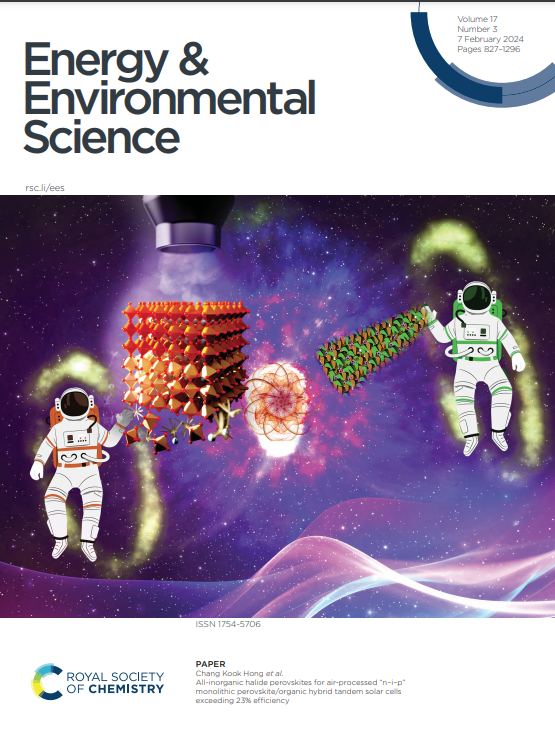Polarity Coupling in Biphasic Electrolyte Enables Iodine/ Polyiodides Co-Extraction for Portable Zn-Iodine Batteries Following Liquid-Liquid Conversion Route
IF 32.4
1区 材料科学
Q1 CHEMISTRY, MULTIDISCIPLINARY
引用次数: 0
Abstract
The shuttle effect of polyiodides and aggregation of solid iodine on the cathode surface in aqueous Zn-iodine batteries are considered as the main issues for unsatisfactory cycling stability and slow charge transfer kinetics, respectively. Herein, we develop a biphasic (BP) electrolyte composed of immiscible organic (ethyl acetate, EA) and aqueous solvents for the co-extraction of iodine/polyiodides. The underlying mechanism is clarified by the principle of polarity coupling between iodine species and solvent molecules. Notably, distinct from the formation of solid iodine in aqueous electrolyte, the electrochemical redox reactions of iodine/polyiodides at the cathodic side (organic phase) investigated by rotating ring electrode follow the liquid-liquid conversion route. Accordingly, the diffusion of polyiodides is effectively suppressed at the interface of BP electrolyte and the absence of solid iodine deposition significantly enhances charge transfer kinetics. Moreover, the quasi-solid-state Zn-iodine batteries featuring with gravity-independent stratified architecture is demonstrated, enabled by a BP systems consisting of microspace-confined EA and PAM-CMC hydrogel. The fabricated portable devices exhibit an areal capacity of 1.40 mAh cm-2 at 1 mA cm-2, improved rate performance and stable cycling performance over 22,000 cycles at 10 mA cm-2, indicating extraordinary reliability for wearable applications.双相电解液极性耦合实现便携式锌碘电池液-液转换路径下碘/多碘化物共萃取
多碘化物的穿梭效应和固体碘在阴极表面的聚集分别被认为是导致水基锌碘电池循环稳定性不理想和电荷转移动力学缓慢的主要原因。在此,我们开发了一种由不混相有机(乙酸乙酯,EA)和水溶液组成的双相(BP)电解质,用于碘/多碘化物的共萃取。碘与溶剂分子的极性耦合原理阐明了其潜在的机理。值得注意的是,与固体碘在水电解质中的形成不同,旋转环电极研究的碘/多碘化物在阴极侧(有机相)的电化学氧化还原反应遵循液-液转化路线。因此,聚碘化物在BP电解质界面的扩散被有效抑制,固体碘沉积的缺失显著增强了电荷转移动力学。此外,还展示了具有不依赖重力分层结构的准固态锌碘电池,该电池由微空间受限EA和PAM-CMC水凝胶组成的BP系统实现。制造的便携式器件在1毫安时的面容量为1.40毫安时的cm-2,在10毫安时的22,000次循环性能和稳定的循环性能得到改善,表明可穿戴应用具有非凡的可靠性。
本文章由计算机程序翻译,如有差异,请以英文原文为准。
求助全文
约1分钟内获得全文
求助全文
来源期刊

Energy & Environmental Science
化学-工程:化工
CiteScore
50.50
自引率
2.20%
发文量
349
审稿时长
2.2 months
期刊介绍:
Energy & Environmental Science, a peer-reviewed scientific journal, publishes original research and review articles covering interdisciplinary topics in the (bio)chemical and (bio)physical sciences, as well as chemical engineering disciplines. Published monthly by the Royal Society of Chemistry (RSC), a not-for-profit publisher, Energy & Environmental Science is recognized as a leading journal. It boasts an impressive impact factor of 8.500 as of 2009, ranking 8th among 140 journals in the category "Chemistry, Multidisciplinary," second among 71 journals in "Energy & Fuels," second among 128 journals in "Engineering, Chemical," and first among 181 scientific journals in "Environmental Sciences."
Energy & Environmental Science publishes various types of articles, including Research Papers (original scientific work), Review Articles, Perspectives, and Minireviews (feature review-type articles of broad interest), Communications (original scientific work of an urgent nature), Opinions (personal, often speculative viewpoints or hypotheses on current topics), and Analysis Articles (in-depth examination of energy-related issues).
 求助内容:
求助内容: 应助结果提醒方式:
应助结果提醒方式:


